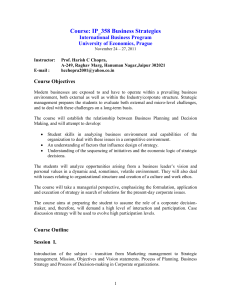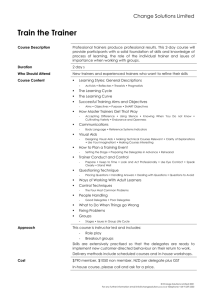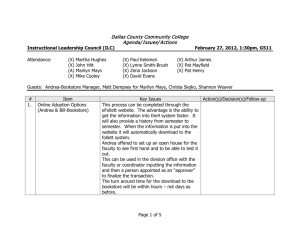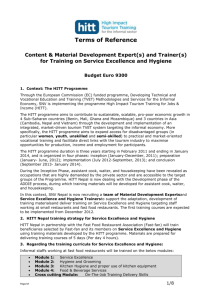T3-for-EFS
advertisement
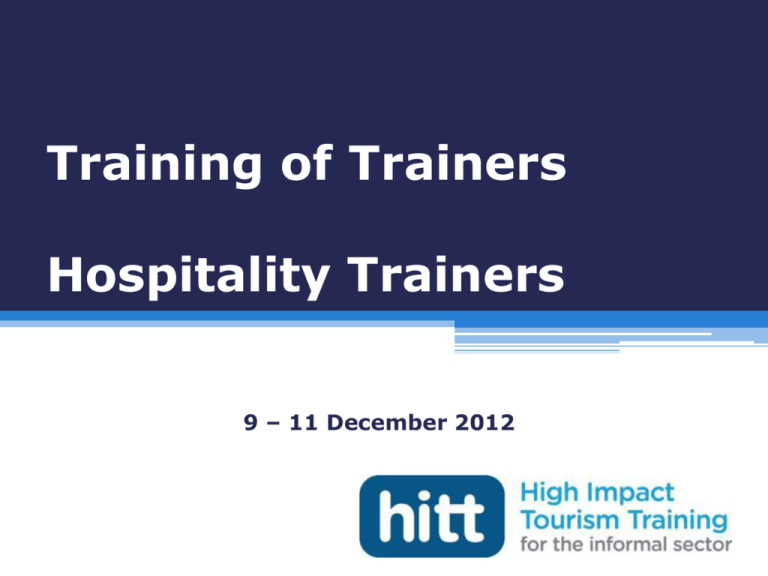
Training of Trainers Hospitality Trainers 9 – 11 December 2012 1 Introductions Your facilitator: Delegates: Please briefly introduce yourself with your: • Name • Current job • Brief professional background • What is the strangest thing you have ever eaten? 2 Our Programme: • • • • The HITT Approach to Learning Trainer Professional Development Training Resources & Support HITT Learning Methods and Tools 3 Why is this course important to you? Professionally: • Skills and competence as trainers • Increase technical knowledge Personally • Self-confidence • Self-development HITT A brief introduction 5 HITT Global HITT aims to improve access to quality jobs in the tourism and hospitality sector for underprivileged people in seven developing countries in • Sub-Saharan Africa (Benin, Ghana, Mali, Mozambique) • Asia (Cambodia, Nepal & Vietnam). HITT offers an integrated, market driven training approach in close co-operation with leading industry partners. • 80% funded by the European Commission • 20% co-funded and implemented by SNV Netherlands Development Organisation and its national partners in each of the participating countries. 6 HITT Nepal The HITT Nepal target is to train 1,000 people from informal and potential workers with an emphasis on unemployed and underemployed and on youth and women. We will be training across the following occupations: • Homestay operators • Mountain Leaders • Waiters • Cooks • Housekeepers • Fast Food restaurants The HITT Approach to Learning The principles and practices of our Approach 8 Characteristics of a good Trainer Who was the best trainer you every had, and why? Was it the person or the materials? What makes good training materials? 9 HITT Training Approach The HITT Approach enabling environment and elements Learner Actors in the HITT Training System Trainers Industry Enterprises 10 HITT Learning Approach The following core elements are the foundation for any HITT learning interventions: • • • • • Andragogy Acknowledge Prior Learning Active Learning Integrated Learning Creating Motivation for Learning (ARCS) 11 Andragogy: teaching adults HITT learners are adults with existing life skills and knowledge that form a foundation for the training How to achieve this: Trainers must: • Clearly explain why the learning is important to the learners at the beginning of training • Find out what they know and build on it • Emphasise practical more than theory training • Use a wide range of learning activities 12 Acknowledge Prior Learning • HITT targeted beneficiaries will possess existing knowledge, beliefs, attitudes and a range of skills and experience • These can help or hinder training – make them HELP! • Use the existing skills and experience that your learners possess 13 Active Learning 14 Integrated Learning Teaching and learning different content at same time: Ideas from the floor? 15 Motivation Creating motivation for learning using the ARCS principles: • Attention • Relevance link • Confidence • Satisfaction Practice: how can you get attention from learners at the beginning of a lesson? HITT Trainers: Ongoing Professional Development 17 HITT Trainers…. Love Active Learning! • Are punctual and keep good time • Are well prepared, with well equipped training kits • Encourage all delegates to participate in training • Are kind and patient, especially with skills training • Are energetic and believe that training is a form of entertainment • Notice when delegate’s energy is low • Keep eye contact with delegates • Learn all delegates’ names quickly, and use these names (using name cards) • Provide rewards for excellent participation 18 HITT Trainers…. Think on their feet: • Adapt to the training environment • Use what you have at hand • Understand the training environment and change the content of the training if needed: e.g. ingredients, dishes, types of materials, etc. How to keep up to date: • Ideas… Brainstorming 19 How to keep up to date: Ideas… Develop and maintain industry networks: • Join and become active members of industry associations – both attend and host meetings ▫ REBAN, HAN, Fast-Fan • http://www.rebanpokhara.com • Make friends with industry suppliers – they can demonstrate new products to students 20 How to keep up to date: Ideas… • Read industry publications: Food and Wine Magazine Nepal • http://www.fnw.com.np • ECS Magazine 21 Other ideas to keep current… • • • • • • Surf the ‘Net Travel!? Eat out Do free on-line courses (OTT) Watch TV (MasterChef, Jamie Oliver, etc) Attend industry delivered courses 22 Training Preparation, Resources and Skills Tips and codes for delivering excellent training 24 Trainer kits Materials and resources to enhance your training. • Paper-based • Equipment-based resources • Samples and examples Resources are indicated in your facilitator guide 25 Your Training Room • How will you make your training venue a good learning space? • Educational materials Resources 26 Venue Set-up Delegate space: • Seat in small groups, at tables if possible – this helps with group work • Or U-shaped for access Trainer space: • Table for your kit and materials • Space for your flip file – clearly seen by everyone • Chair • Water 27 Training Pre-prep • • • • • • Check your kit that everything is there Replace items you have used Review the content of the lesson Read the tips Check the arrangements: dates, location, venue Check the paperwork – attendance registers 28 Mobile Training Preparation Arrival at location – what should you do? • Check your venue for correct seating, facilities, etc. • Check practical training facilities and equipment ▫ Improvise if facilities are lacking: ▫ Revise recipes, revise methods or tools • Set up training kit • Prepare for demonstrations • Prepare for activities Tip: Think on your feet: you know what to deliver, maybe you will have to make a few changes to how you do it in a particular place! 29 HITT Training skills Using training resources: Make sure these are ready and accessible on a table, tray, etc. before they are needed Prepare in advance for demonstrations • Equipment • Resources Prepare in advance for complex activities: • Tastings • Identification tests 30 HITT Training skills Using Power Point: • Clear slides • Simple bullet points • No rubbish clip art or Word art • Simple templates • Clear fonts • Consistent fonts, sizes, bullets, etc • Use for showing picture slide shows •Serif font Using data projector • Face your students • Stand • Use media pointer if possible – gives you flexibility to move around and not stand behind computer 31 Industry Resources • • • • • • Posters Tent cards Menus Websites Advertisements Catalogues 32 Advertisements 33 Presentation Skills • Face your students as much as possible • Move around the room – do not hide behind a desk or stand like a statue in the front • Keep your own energy up – keep moving! • Entertain your delegates – keep them interested • Use humour and energy to keep delegates focused • Don’t read – unless it is in an activity • Stand straight and be confident • Project your voice – delegates must hear you • Circulate during group activities to help and guide groups • Have fun! 34 Icebreakers What is an icebreaker? When do you use one? Elements of icebreakers? 35 Activity: Icebreakers Small Group Activity: Groups of 3: each come up with an icebreaker they have used that works in Nepal. Demonstrate it. 36 Energisers • Times when energy levels fall and people’s attention wanders: ▫ at the end of the morning, ▫ just after lunch ▫ towards the end of the day. • If energy levels in the room are low – wake your delegates up! • What ideas work in Nepal? 37 Quiet or Shy Delegates HITT trainers ensure everyone participates! How? • Ask them direct questions • If someone is dominating them, move people around in the room • Put quiet people in one group together so that they will have to communicate with each other and provide feedback • Have a word with them at break to see if they are keeping up and are OK 38 Gender Sensitivity Women may not speak up – how to encourage them to participate? Ideas from the floor? 39 Using Games We all like to play! • Quizzes • Competitions • Matching cards • Other… 40 Remembering Names Important to use delegate names! Simplest way: name cards Link a description with same starting sound to the name : • Lucky Lisa • Brave Bibek • Creative Krishner • Gentle Jon 41 Using Prizes and Rewards • What are prizes and rewards? • Why and what for? • What can you use? • When? 42 Methods to Divide Groups Ideas from the floor? • • • • Counting Stickers Playing cards Theme cards High Impact Training Methods Ideas for delivering High Impact Training 44 Posters Very useful teaching tool! • Check if students understand what they have learned • Provides an opportunity to correct and guide students • Use posters as classroom décor and learning materials • Provides fun and competition • Provide simple A0 paper and wax crayons • How to judge best? 45 Activity: Poster Making In groups of 4, 1. Discuss and agree the criteria for a good poster 2. Design and draw a poster to show these criteria • Present the poster • The best poster will win a prize! 46 Posters Criteria: • Bold • Colourful • Simple • Easy to read from far • Eye-catching • Accurate information 47 Posters What: Means for students to research information or present information that they have learned in a creative way How: • Provide simple A0 paper and wax crayons • Each student has one vote to vote for the poster they think is best but may not vote for their own • Poster with most votes wins a reward/prize When: • To check if students understand what they have learned • Provides an opportunity to correct and guide students • Use posters as classroom décor and learning materials • Provides fun and competition 48 Flashcards Many ideas and uses: • • • • • • • • Matching words and pictures Completing sentences Identifying objects Display thinking (e.g pest cards) Role play scenarios Teaching English Games Identify problems and proposing solutions 49 Activity: Flashcards • Coffee matching • Sequencing of: ▫ Cleaning a room ▫ Service procedures • Organogram • Pests 50 Video • YouTube (downloader) • Many in English • Can translate as they are played • Or choose ones with no sound or speaking videos • Can be useful for barista training, service techniques, etc. • Example: Coffee art: Link1 • How to hyperlink… 51 Experiments What? • A demonstration of cause-and-effect How? • Jelly experiment • Baking Powder When? • When you need to demonstrate something that will have lasting impact and will be remembered 52 Activity: Experiments • Test egg freshness: video link • Testing baking powder 53 Activity: Identification Test • Enjoy your identification test…. 54 Identification tests What? • Activity to introduce new things to students in a fun and interesting way. How? 1. Lay a selection of common and less known items out on a surface – each must have a number attached to it 2. Students to write what they think each item is on a sheet of paper. 3. Trainer to ask what each item is – give clues, praise students for right answers, then explain and demonstrate each item. 4. Student/s with highest score get a small prize or treat When? • To introduce students to new or some familiar items 55 Activity: Identification Tests Class Practice: • Working in groups of 3, 1 member of each group must prepare and present a identification test to the whole group, then coach them in that skill. 56 Role Play What? • A small ‘play’ to tell a story about a situation and how staff handle particular situations How? • Teach students a particular technique • Demonstrate the technique • Divide students into groups • Provide each group with scenes to play • They must practice handling the situation using the technique you have taught them • All groups can practice at same time – F&B Facilitator and assistant can circulate and assist and guide the groups till they get it right. • Debrief afterward When? • To act out scenes that are likely to happen in industry • Teaching ‘soft skills’ like engaging with guests, handling complaints, etc. 57 Role Play What? • A small ‘play’ to tell a story about a situation and how staff handle particular situations How? • Teach students a particular technique • Demonstrate the technique • Divide students into groups • Provide each group with scenes to play • They must practice handling the situation using the technique you have taught them • All groups can practice at same time – F&B Facilitator and assistant can circulate and assist and guide the groups till they get it right. • Debrief afterward When? • To act out scenes that are likely to happen in industry • Teaching ‘soft skills’ like engaging with guests, handling complaints, etc. 58 Role Play: Handling Complaints HEAT four step approach: • Hear them out: listen carefully and attentively without becoming defensive • Empathize: Be sympathetic to how he or she is feeling. • Apologize: say ‘Sorry’ that the situation has happened • Take responsibility for action: Fix the problem immediately. It might be appropriate to ask the customer: ▫ What would make him or her happy? ▫ How could we rectify this situation? ▫ What solution would you see as a satisfactory one? 59 Activity: Role Play • Take the HEAT • Trainer will demonstrate the technique • In groups of 4, practice the technique, using role plays from the HITT Homestay course 60 Demonstrations What: Showing students a technique/skill How: 1. Practice before hand 2. Gather all materials and equipment 3. Arrange all items ready for use 4. Make sure enough space for all to see 5. Go through all steps of the procedure 6. Allow time for delegates to see, touch, taste, feel where possible. 7. Delegates must then practice with trainer coaching them 61 Activity: Demonstration • Service procedure: • Cross Contamination Class Demonstrations: • Working in groups of 3, 1 member of each group must prepare and present a demonstration to the others, then coach them in that skill. 62 Tasting What? • Opportunity to try food and beverage items used in menus or cooking How? • 2 kinds: ▫ Blind: identify which product is the best ▫ Open: learning about new products and how they taste When? • When introducing food and beverages items that students may not be familiar with. • Introducing new menu items • Adding new products to menu or stock lists • Comparing the quality of different brands of food to put on a menu or product list 63 Activity: Blind Tasting • Chocolate tasting! • Using the tasting template in your manual, rate each of the four samples of chocolate. No 1 2 3 4 5 Colour /10 Texture Flavour /10 /10 Total /30 64 Blind Tasting • • • • All products must be the same Number and label Score Price can be a factor 65 Activity: Open Tasting • Beverage mixers • Using the tasting template in your manual, capture information on each of the items you taste. No 1 2 3 Name Use Notes 66 Activity: Tastings Class Practice: • Working in groups of 3, 1 member of each group must prepare and present a tasting to the others, then coach them in that skill. 67 Activity: Guest Lecturer • Welcome our special guest lecturer! • Take notes • Ask questions! 68 Guest Lecturer What? • Specialist speaker to present info on specialist skills, do demonstrations How? • Source experts • Invite them to speak • Brief them VERY WELL • Arrange a “Thank You” Examples: • Cocktail making • Pest control 69 Class Debates What? • Opportunity to research a topic and presents a case in its favour How? • Divide class into teams and give each team a topic to build a case on. • Provide each team with time to prepare • Each team to appoint a compelling speaker to make their case • Each team presents their argument in 5 minutes • Class votes for best case When? • Studying controversial topics – such as pooling tips, ‘the customer is always right’, etc. 70 Activity: Class Debate • Divide into 2 teams • Choose a name for your team Topics to prepare and present: • Team 1 & 3: Why you should use guest speakers in your training • Team 2 & 4: Why you should not use guest speakers in your training Each group gets 10 minutes to prepare, and 5 minutes to present their case. 71 Case Studies What: Using a real work-related situation to analyse and learn from How: • Find a good case study story – usually in the media • Source news articles, internet, etc • Develop questions to challenge understanding, problem solving, thinking and understanding of consequences, responsibilities • Set questions based on the scenario 72 Activity: Case Study Read the case study handed out to you • In groups of 3, analyse the situation: ▫ What were the issues mentioned by the writers? ▫ What should the restaurant do to address the issues? ▫ How should the restaurant respond to the writers ▫ What can we learn from these reviews? 73 Industry Visits What? • Taking students on a visit to a local or national place of interest that links to the Passport curriculum to assist them to use all their senses to learn Purpose • To show students the “real world” of hospitality • To consolidate learning – particularly knowledge content that has been learned only abstractly from the written word • For learners to have fun! 74 Industry Visits How? • Plan ahead: book all logistics with site • Set up question sheets • Arrange indemnity and transport Examples of Familiarisation Trips: • Hotels • Restaurants • Food processing plants or markets 75 Activity: Industry Visit We will be visiting the back of house areas of the Marshyangdi Hotel as an industry visit. • In groups of 3, prepare a question sheet for the ‘students’ to complete while on their visit. 76 Games What? • Opportunity to learn through fun • word searches, crossword puzzles, • matching exercises, • sorting games/activities • Dictionary search How? • Develop games with various tools • Use imagination When? • “test yourself’ opportunities • Assessments to check learning 77 Games Why? • To have students actively engaged in consolidating their learning • To create fun for students while they are learning Advantages • Games lend themselves very well to consolidating students’ concepts • Games can keep students happily engaged during those times that they are free in class • The competitive spirit encourages students to participate 78 Games • www.puzzle-maker.com • www.discoveryeducation.com/puzzlemaker/ • Welcome to Puzzlemaker! Puzzlemaker is a puzzle generation tool for teachers, students and parents. Create and print customized word search, criss-cross, ... www.eclipsecrossword.com/ • It's never been simpler—just give EclipseCrossword a list of words and clues, and it does the rest. In seconds, you'll have a crossword puzzle with just the words ... Types of waste Waste is separated into: Recyclable and Non-recyclable Recyclable Non-Recyclable Separated into organic and inorganic Separated into organic and inorganic Types of waste Waste is separated into: Recyclable and Non-recyclable Recyclable Separated into organic and inorganic Organic Uncooked production waste: peelings, trimmings, etc Types of waste Waste is separated into: Recyclable and Non-recyclable Recyclable Separated into organic and inorganic Organic Uncooked productio n waste: peelings, trimmings , etc Inorgani c Glass Paper Cans Plastic E-waste Types of waste Waste is separated into: Recyclable and Non-recyclable Recyclable Separated into organic and inorganic Organic Uncooked production waste: peelings, trimmings, etc Inorganic Glass Paper Cans Plastic E-waste Non-Recyclable Separated into organic and inorganic Organic Cooked food waste: plate waste, bones, etc Types of waste Waste is separated into: Recyclable and Non-recyclable Recyclable Separated into organic and inorganic Organic Uncooked production waste: peelings, trimmings, etc Inorganic Glass Paper Cans Plastic E-waste Non-Recyclable Separated into organic and inorganic Organic Cooked food waste: plate waste, bones, etc Inorgani c Hazardous e.g. batteries, chemicals, fluorescent light bulbs 84 Activity: Games • Sort the bags of waste into different types • In groups, using phones, find definitions of “service excellence” then from those, come up with your own definition 85 Checklist Look at page 10 of your manual… Let’s complete the checklist 86 Team Quiz What? • Fun activity to test knowledge – also keeps students alert during class in anticipation of quiz. How? • Develop set of questions and answers on a particular set of knowledge – e.g. drinks service • Divide group into 2 or 3 teams • Each team must have a name • Ask each team a question in turn • If they get it right, they get 2 points • If not, it goes to the next team for 1 point • Team with most points at end wins • Provide small prizes for winning team When? • At the end of a section of work or week 87 Activity: Team Quiz • In groups of 4, design and draw a poster to show the criteria for judging good posters: • Present the poster • The best poster will win a prize! 88 Storytelling What? • Using a real life story or incident to provide an example or case study about a topic in the curriculum How? • Source real stories from the news, internet or from colleagues and friends – these must be linked to a curriculum topic • Prepare questions about the story in advance • Write or copy the story, and either memorise and tell, or read it to students • Ask and discuss the questions after the story. E.g. ▫ ▫ ▫ ▫ What would have changed if… How could this have been prevented? How else could this have ended? Who were the main people involved – how did they contribute to the situation? When? • To get and keep student interest in a topic that may not be that interesting • To use real examples for the world of work 89 Activity: Storytime Once there lived a village of creatures along the bottom of a great crystal river…. Thank You… And Good Luck….! 91 Preparation for next 2 days
